Effect of Brick Aggregate Content on Performance of Recycled Construction-Solid-Waste Aggregate
Abstract
:1. Introduction
1.1. Research Background
1.2. Research Plan
2. Materials and Methods
2.1. Properties of Construction-Solid-Waste Materials
2.2. Research Method
2.2.1. Laboratory Tests
2.2.2. Field Investigation
3. Effect of Brick Aggregate Content on Performance of Mixed Recycled Aggregate
3.1. Effect of Brick Aggregate Content on CBR
3.2. Effect of Brick Aggregate Content on Crushing Value
4. Field Compaction of Recycled Aggregate
4.1. Evaluation of Field Compaction Quality
4.2. Compaction Parameters of Construction-Solid-Waste Subgrade
5. Conclusions
- (1)
- A brick aggregate content less than 80% had little effect on the gradation of mixed recycled aggregate. During the compaction process, the recycled aggregate with a particle size of 9.5 mm to 19 mm was crushed to a higher degree, and a larger amount of brick aggregate led to a higher degree of crushing.
- (2)
- With an increase in brick aggregate content, the CBR decreased continuously, and when the content was 0–40%; the reduction rate of the CBR was smaller than that found for 40–100% content. However, even when the content of brick aggregate was 100%, the CBR was much higher than the technology standard requirement of 8%.
- (3)
- The crushing value of the mixed recycled aggregates increased with an increase in brick aggregate content. The larger the value of the latter, the greater the dispersion of the test results and the greater the influence of the soaking crushing value. When the brick aggregate content was greater than 40%, the crushing value of the recycled aggregates increased sharply, and the crushing resistance decreased noticeably.
- (4)
- With an increase in brick slag content, the resilience modulus decreased, the deflection increased, and the brick aggregate content affected the uniformity of compaction. When the brick aggregate content was 40%, the construction uniformity was good.
- (5)
- The recommended ratio of brick aggregate to recycled concrete aggregate for mixed recycled construction-solid-waste aggregate is 40% to 60%. The results show that the subgrade filling construction method, whereby a 22 t roller is used for compaction for five passes (two weak vibrations + two strong vibrations + one weak vibration) at a speed of 3 km/h in the main compaction stage, achieves better construction quality.
- (6)
- Due to limitations in engineering practices, only recycled aggregates with six different brick aggregate contents were selected for performance evaluation in this study. Future research could continue to analyze the influence of subgrade structural parameters on the performance of recycled aggregates from construction solid waste based on further field testing.
Author Contributions
Funding
Institutional Review Board Statement
Informed Consent Statement
Data Availability Statement
Conflicts of Interest
References
- Yu, H.; Ge, J.; Qian, G.; Zhang, C.; Dai, W.; Li, P. Evaluation on the rejuvenation and diffusion characteristics of waste cooking oil on aged SBS asphalt based on molecular dynamics method. J. Clean. Prod. 2023, 406, 136998. [Google Scholar] [CrossRef]
- Chen, Y.; Pei, Z.; Mao, X.; Fan, L.; Xu, M.; Li, Y.; Wang, D.; Yi, J. Evaluation of electromagnetic scattering characteristics of construction solid waste—A theoretical study of solid waste identification. Sci. Total Environ. 2024, 927, 172312. [Google Scholar] [CrossRef] [PubMed]
- Cong, H.; Meng, H.; Chen, M.; Song, W.; Xing, H. Co-processing paths of agricultural and rural solid wastes for a circular economy based on the construction concept of “zero-waste city” in China. Circ. Econ. 2023, 2, 100065. [Google Scholar] [CrossRef]
- He, Z.; Xie, T.; Yu, H.; Ge, J.; Dai, W. Evaluation of quantum dot composite graphene /Titanium oxide enhanced UV aging resistance modified asphalt. Constr. Build. Mater. 2023, 408, 133732. [Google Scholar] [CrossRef]
- Peng, X.; Xie, N.; Xia, C.; Zhou, X.; Zhao, P.; Ma, S.; Zhang, C.; Lv, S. Laboratory evaluation of different bio-oil recycled aged asphalts: Conventional performances and microscopic characteristics. J. Clean. Prod. 2023, 428, 139442. [Google Scholar] [CrossRef]
- Wang, P.; Xu, C.; Li, Q.; Wang, L.; Guo, Y. Experimental study on the preparation of wood aggregate recycled concrete using waste wood and recycled fine aggregate from construction and demolition wastes. J. Build. Eng. 2024, 90, 109471. [Google Scholar] [CrossRef]
- Khan, Z.A.; Balunaini, U.; Costa, S. Environmental feasibility and implications in using recycled construction and demolition waste aggregates in road construction based on leaching and life cycle assessment—A state-of-the-art review. Clean. Mater. 2024, 12, 100239. [Google Scholar] [CrossRef]
- Zhang, C.; Yu, H.; Zhu, X.; Yao, D.; Peng, X.; Fan, X. Unified Characterization of Rubber Asphalt Mixture Strength under Different Stress Loading Paths. J. Mater. Civ. Eng. 2024, 36, 04023498. [Google Scholar] [CrossRef]
- Zhu, X.; Qian, G.; Yu, H.; Yao, D.; Shi, C.; Zhang, C. Evaluation of coarse aggregate movement and contact unbalanced force during asphalt mixture compaction process based on discrete element method. Constr. Build. Mater. 2022, 328, 127004. [Google Scholar] [CrossRef]
- Zhu, X.; Yu, H.; Qian, G.; Yao, D.; Dai, W.; Zhang, H.; Li, J.; Zhong, H. Evaluation of asphalt mixture micromechanical behavior evolution in the failure process based on Discrete Element Method. Case Stud. Constr. Mater. 2023, 18, e01773. [Google Scholar] [CrossRef]
- Zhang, Z.; Wang, Q.; Zhang, K.; Fang, J.; Li, S.; Ge, A.; Huang, H. Study on the physical and mechanical properties of recycled weathered rock materials in expressway subgrade in permafrost areas. Constr. Build. Mater. 2024, 430, 136494. [Google Scholar] [CrossRef]
- Zhu, L.; Lei, S.; Li, T. Investigation on thermal performance of recycled brick aggregate concrete structural walls. Constr. Build. Mater. 2024, 425, 136083. [Google Scholar] [CrossRef]
- Dadd, L.; Xie, T.; Bennett, B.; Visintin, P. Exploring the physical and mechanical characteristics of multi-generation recycled aggregate concrete at equivalent compressive strengths. J. Clean. Prod. 2024, 451, 141965. [Google Scholar] [CrossRef]
- Xu, Y.; Chen, H.; Liang, Y.; Shen, J.; Yang, H. Study on fracture characteristics and fracture mechanism of fully recycled aggregate concrete using AE and DIC techniques. Constr. Build. Mater. 2024, 419, 135540. [Google Scholar] [CrossRef]
- Chen, W.-Z.; Chen, X.-F. Experimental Study and Mathematical Modeling of Mechanical Properties of Basalt Fiber-Reinforced Recycled Concrete Containing a High Content of Construction Waste. Constr. Mater. 2023, 3, 462–473. [Google Scholar] [CrossRef]
- Gong, S.; Bai, L.; Tan, Z.; Xu, L.; Bai, X.; Huang, Z. Mechanical Properties of Polypropylene Fiber Recycled Brick Aggregate Concrete and Its Influencing Factors by Gray Correlation Analysis. Sustainability 2023, 15, 11135. [Google Scholar] [CrossRef]
- Khalife, E.; Sabouri, M.; Kaveh, M.; Szymanek, M. Recent Advances in the Application of Agricultural Waste in Construction. Appl. Sci. 2024, 14, 2355. [Google Scholar] [CrossRef]
- Xia, P.; Wang, S.; Gong, F.; Cao, W.; Zhao, Y. Rapid recognition method of red brick content in recycled brick-concrete aggregates and powder based on color segmentation. J. Build. Eng. 2024, 84, 108633. [Google Scholar] [CrossRef]
- Xue, K.; Su, M.; Yang, X.; Qi, J.; Liu, M.; Ju, C.; Peng, X.; Wu, Y. Investigation of the water resistance of non-sintered wrap-shell lightweight aggregates with high content solid waste and its application in water permeable bricks. Constr. Build. Mater. 2023, 400, 132612. [Google Scholar] [CrossRef]
- Zhang, R.; Jiao, J.; He, M.; Tao, Z.; He, P. Design, implementation and performance prediction of profiled steel sheet-mixed aggregate recycled concrete hollow composite slab. J. Build. Eng. 2023, 79, 107839. [Google Scholar] [CrossRef]
- Tafreshi, S.M.; Khanjani, A.; Dawson, A.; Faramarzi, A. Performance of recycled waste aggregate mixed with crushed glass over a weak subgrade. Constr. Build. Mater. 2023, 402, 133002. [Google Scholar] [CrossRef]
- Abbey, S.J.; Amakye, S.Y.O.; Eyo, E.U.; Booth, C.A.; Jeremiah, J.J. Wet–Dry Cycles and Microstructural Characteristics of Expansive Subgrade Treated with Sustainable Cementitious Waste Materials. Materials 2023, 16, 3124. [Google Scholar] [CrossRef] [PubMed]
- Zhi, X.; Yang, T.; Zhang, X.; Ren, Y.; Deng, P.; Chen, Y.; Xiao, Y. Experimental Study on the Mechanical Properties and Permeability of Cement-Stabilized Permeable Recycle Aggregate Materials. Sustainability 2023, 15, 14063. [Google Scholar] [CrossRef]
- Belabbas, O.; Bouziadi, F.; Boulekbache, B.; Hamrat, M.; Haddi, A.; Amziane, S. Mechanical properties of multi-recycled coarse aggregate concrete, with particular emphasis on experimental and numerical assessment of shrinkage at different curing temperatures. J. Build. Eng. 2024, 89, 109333. [Google Scholar] [CrossRef]
- Htet, P.; Chen, W.; Huang, Z.; Hao, H. Physical and mechanical properties of deflection-hardening hybrid fibre-reinforced recycled aggregate concrete. J. Build. Eng. 2024, 90, 109510. [Google Scholar] [CrossRef]
- Hameed, R.; Tahir, M.; Abbas, S.; Sheikh, H.U.; Kazmi, S.M.S.; Munir, M.J. Mechanical and Durability Characterization of Hybrid Recycled Aggregate Concrete. Materials 2024, 17, 1571. [Google Scholar] [CrossRef] [PubMed]
- Deng, M.; Xie, X.; Zhuo, J.; He, Y.; Wang, K. Experimental Study on the Strength and Hydration Products of Cement Mortar with Hybrid Recycled Powders Based Industrial-Construction Residue Cement Stabilization of Crushed Aggregate. Materials 2023, 16, 4233. [Google Scholar] [CrossRef] [PubMed]
- Rasheed, A.H.; Ahmed, B.A. Dynamic monitoring of saturated stiff clay soil foundation structure by falling weight deflectometer system under impact loads sensors effect. Meas. Sens. 2023, 25, 100673. [Google Scholar] [CrossRef]
- JTG E42-2005; Test Methods of Aggregate for Highway Engineering 2005. Ministry of Transport of the People’s Republic of China: Beijing, China, 2005.
- Jianqiao, L.; Xiaodong, Z.; Meng, Z.; Hao, L. Soil Liquid Limit and Plastic Limit Treating System Based on Analytic Method. Procedia Earth Planet. Sci. 2012, 5, 175–179. [Google Scholar] [CrossRef]
- JTG E40-2007; Test Methods of Soils for Highway Engineering. Ministry of Transport of the People’s Republic of China: Beijing, China, 2007.
- JTG/T 3610-2019; Technical Specifications for Construction of Highway Asphalt Subgrades. Ministry of Transport of the People’s Republic of China: Beijing, China, 2019.
- Théréné, F.; Keita, E.; Naël-Redolfi, J.; Boustingorry, P.; Bonafous, L.; Roussel, N. Water absorption of recycled aggregates: Measurements, influence of temperature and practical consequences. Cem. Concr. Res. 2020, 137, 106196. [Google Scholar] [CrossRef]
- Liang, K.; Hou, Y.; Sun, J.; Li, X.; Bai, J.; Tian, W.; Liu, Y. Theoretical analysis of water absorption kinetics of recycled aggregates immersed in water. Constr. Build. Mater. 2021, 302, 124156. [Google Scholar] [CrossRef]
- Jin, L.; Wang, Z.; Wu, T.; Liu, P.; Zhou, P.; Zhu, D.; Wang, X. Mesoscale-based mechanical parameters determination and compressive properties of fully recycled coarse aggregate concrete. J. Build. Eng. 2024, 90, 109366. [Google Scholar] [CrossRef]
- Fanara, A.; Courard, L.; Collin, F.; Hubert, J. Transfer properties in recycled aggregates concrete: Experimental and numerical approaches. Constr. Build. Mater. 2022, 326, 126778. [Google Scholar] [CrossRef]
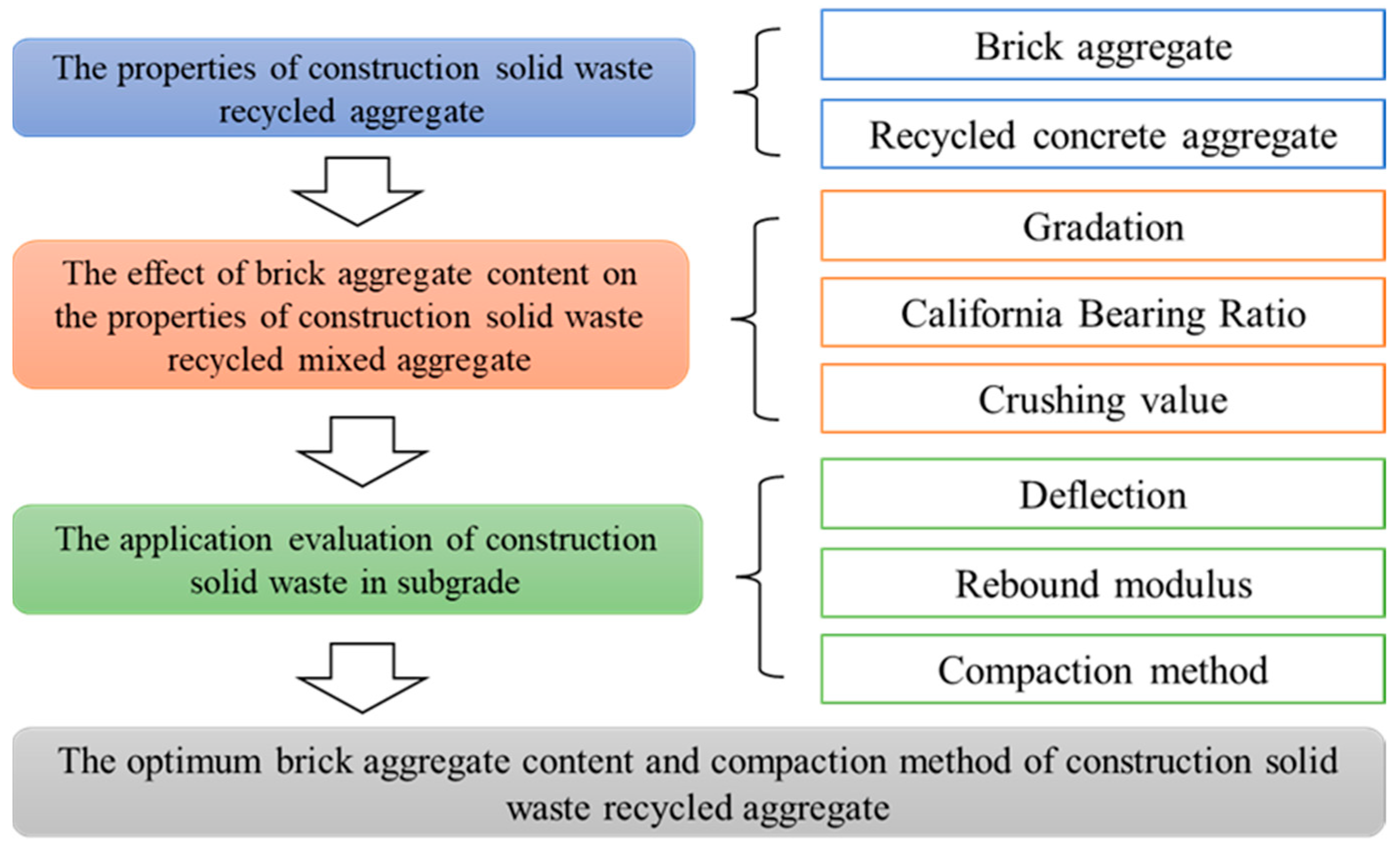
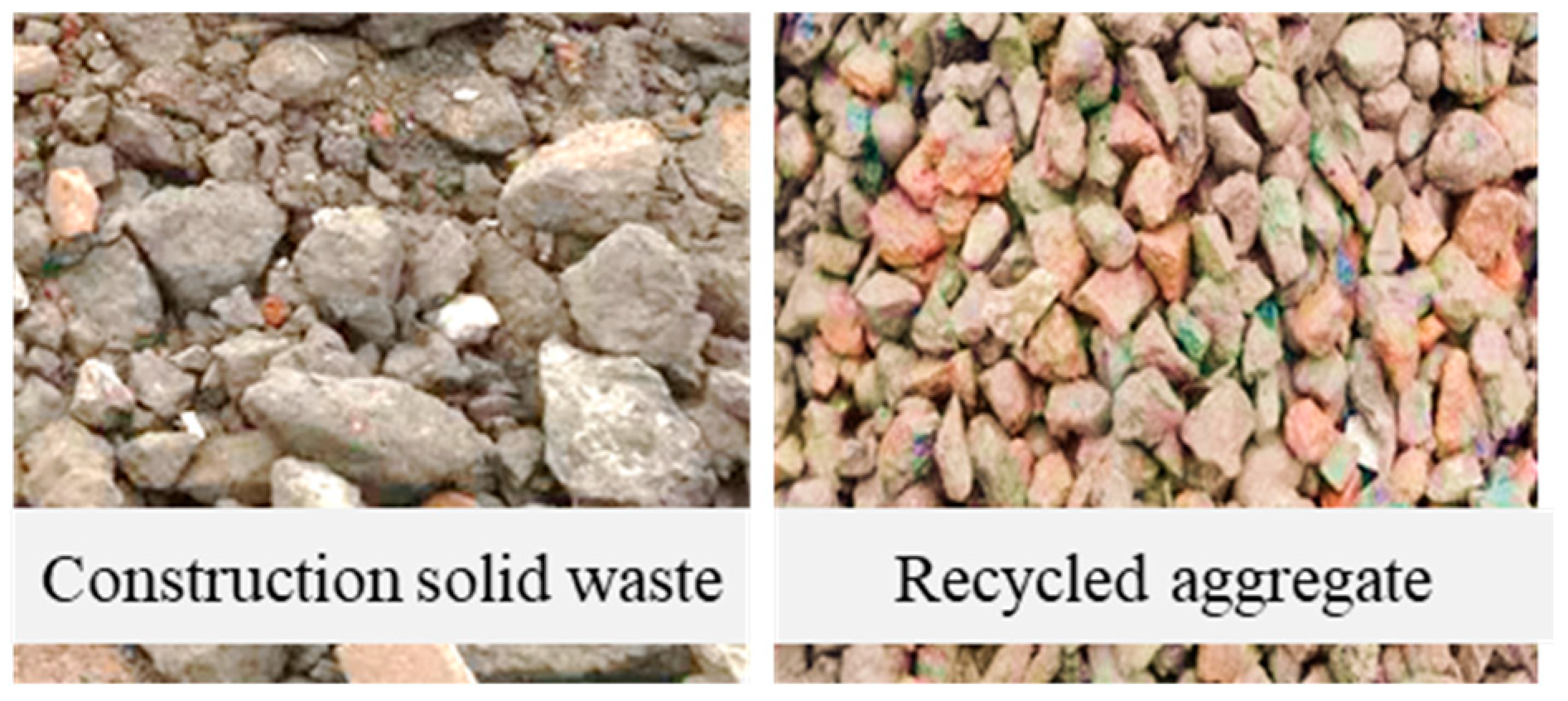
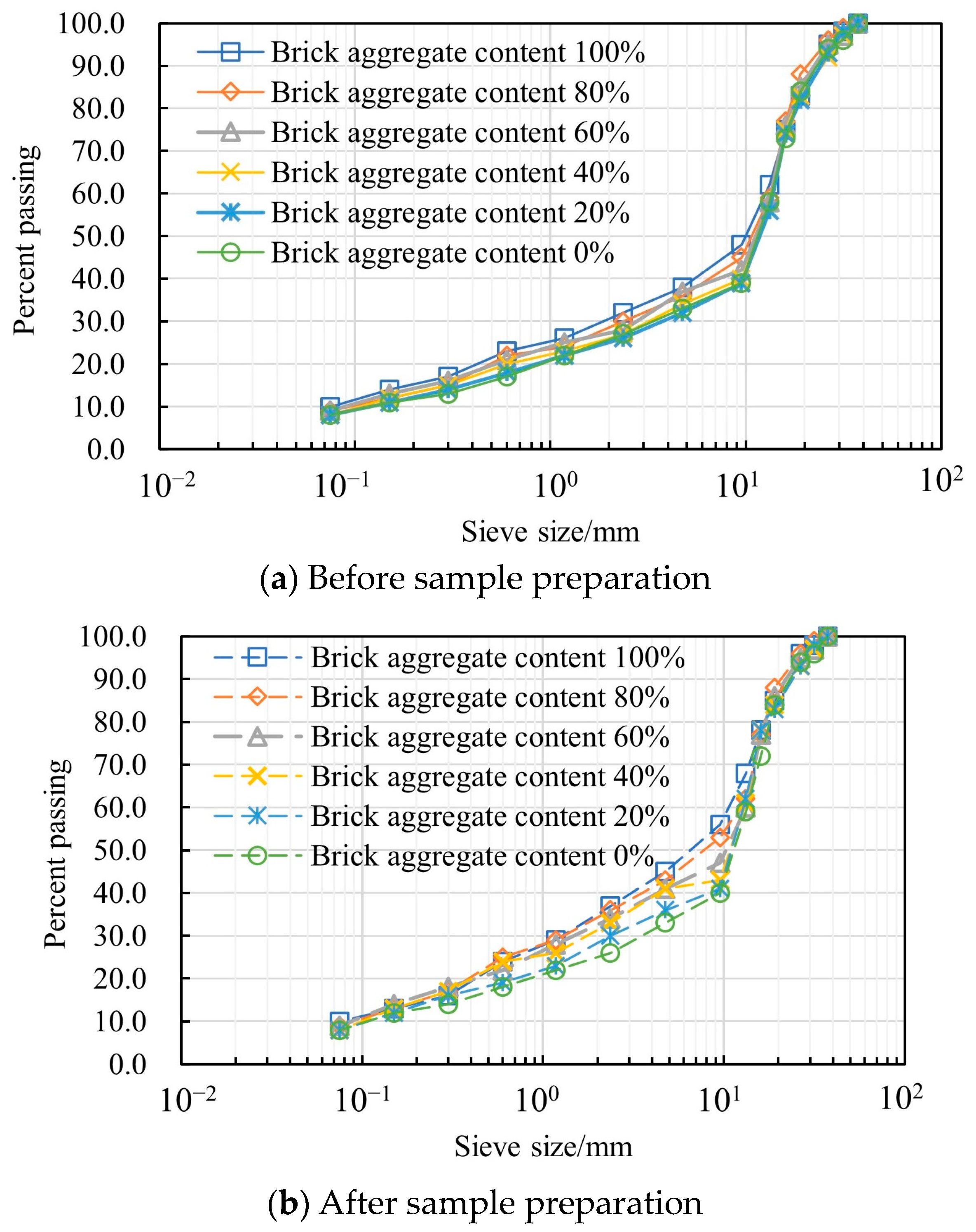

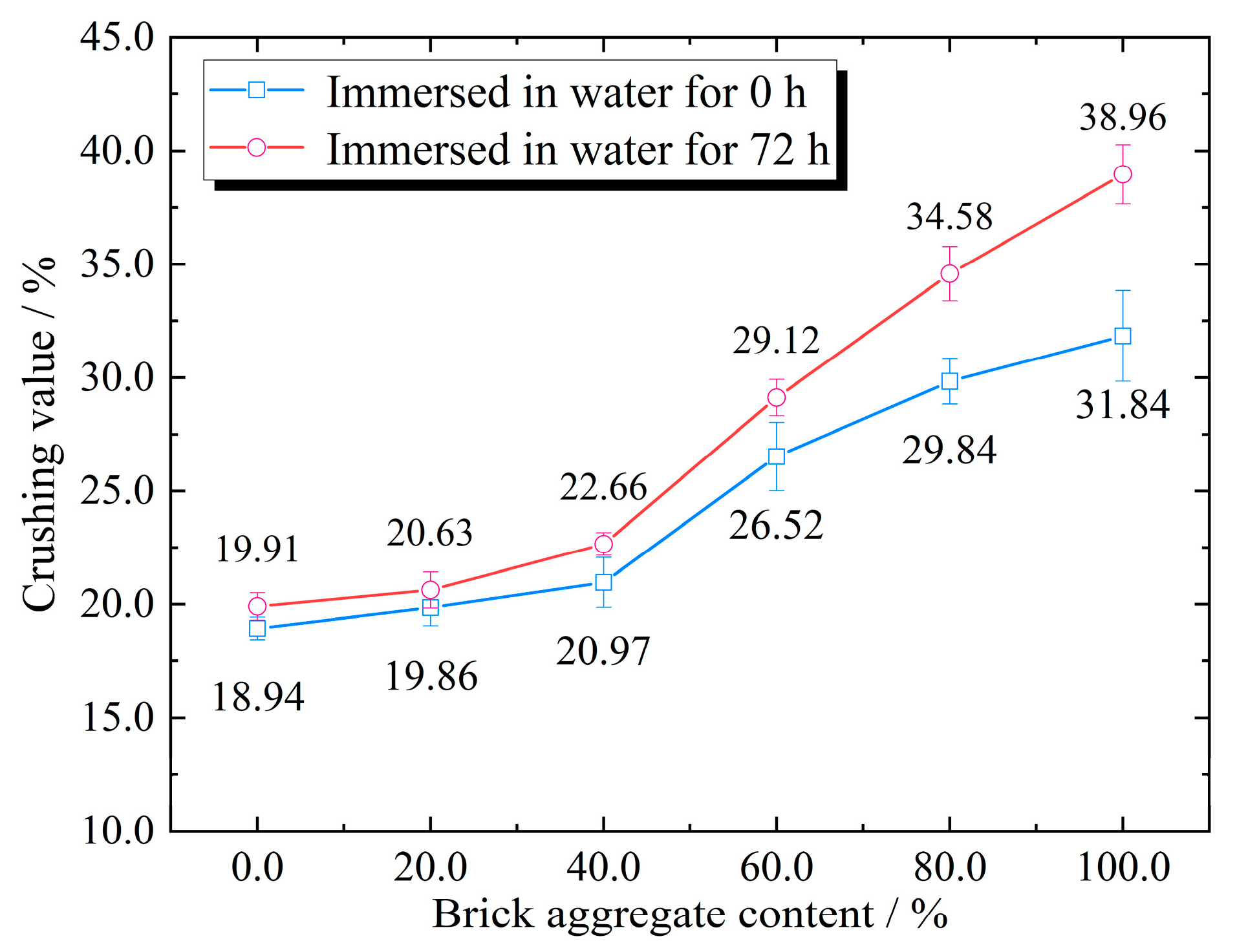
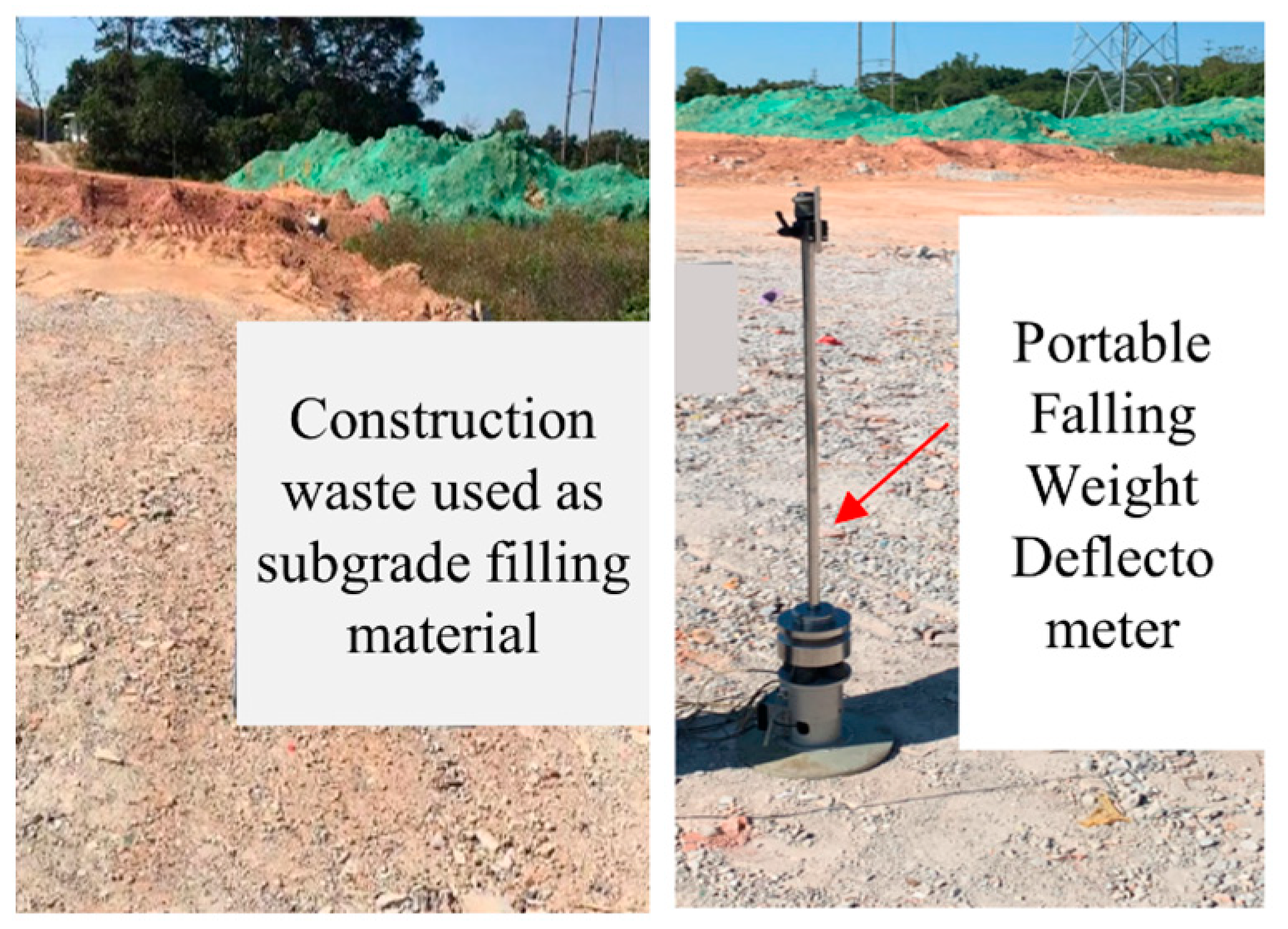
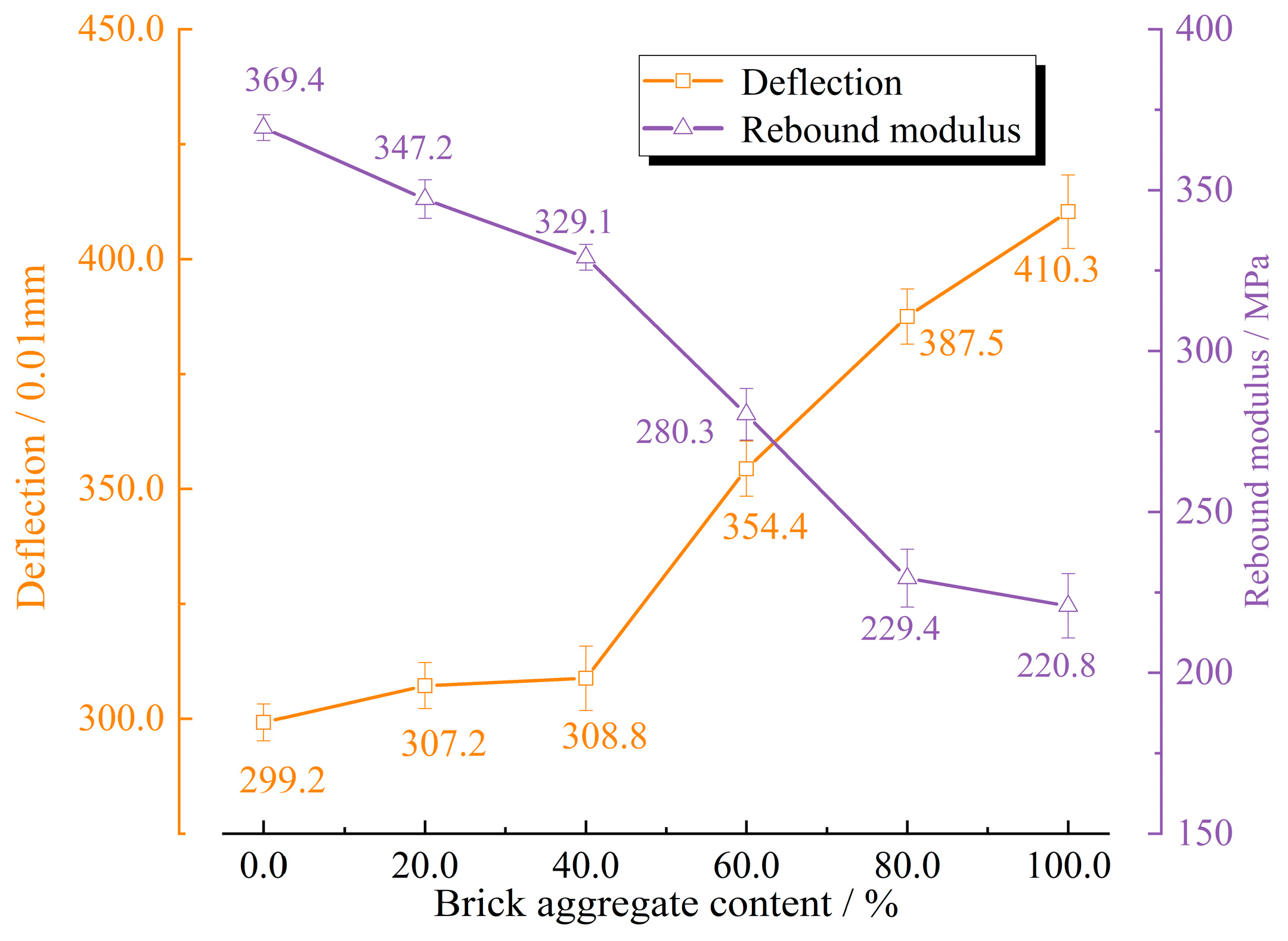
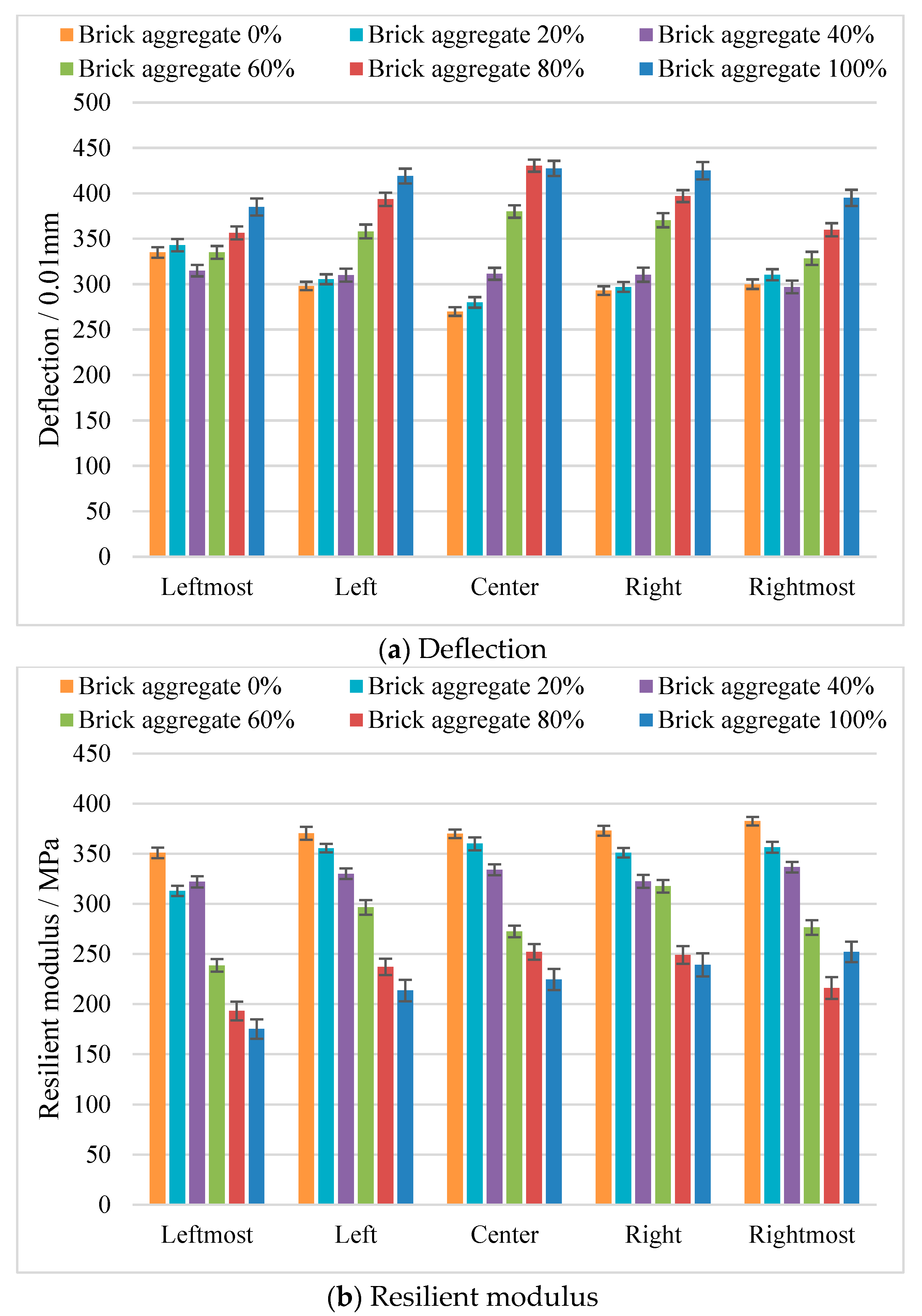
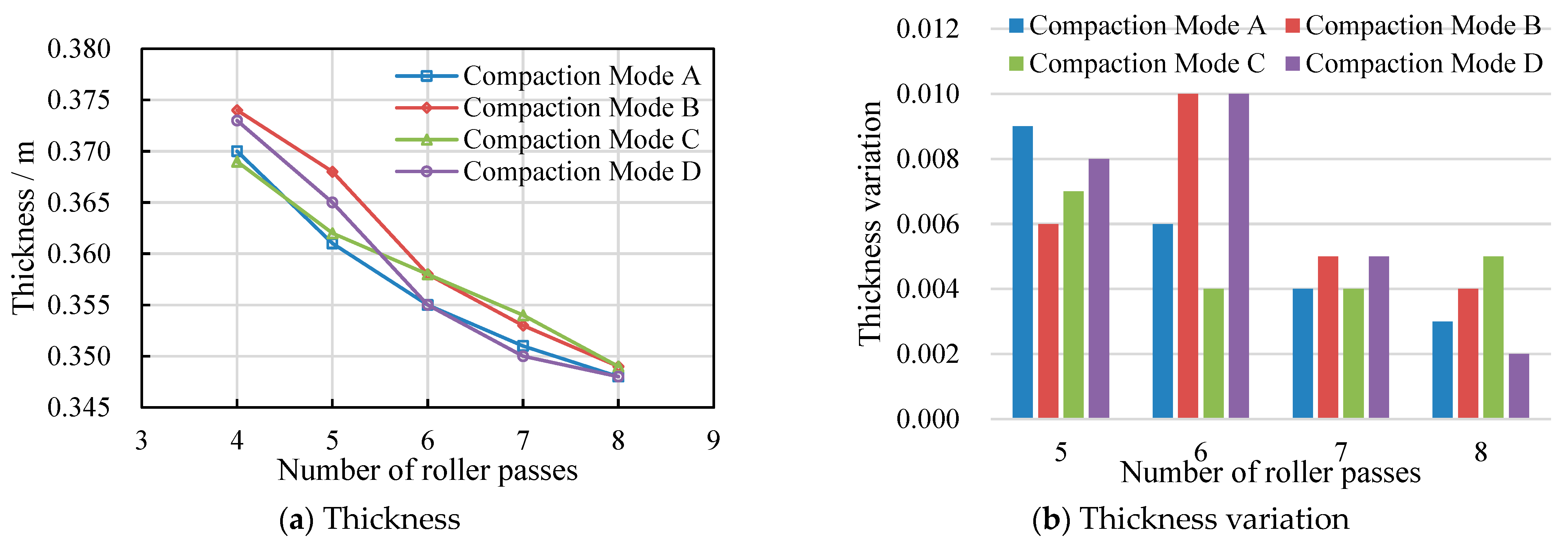
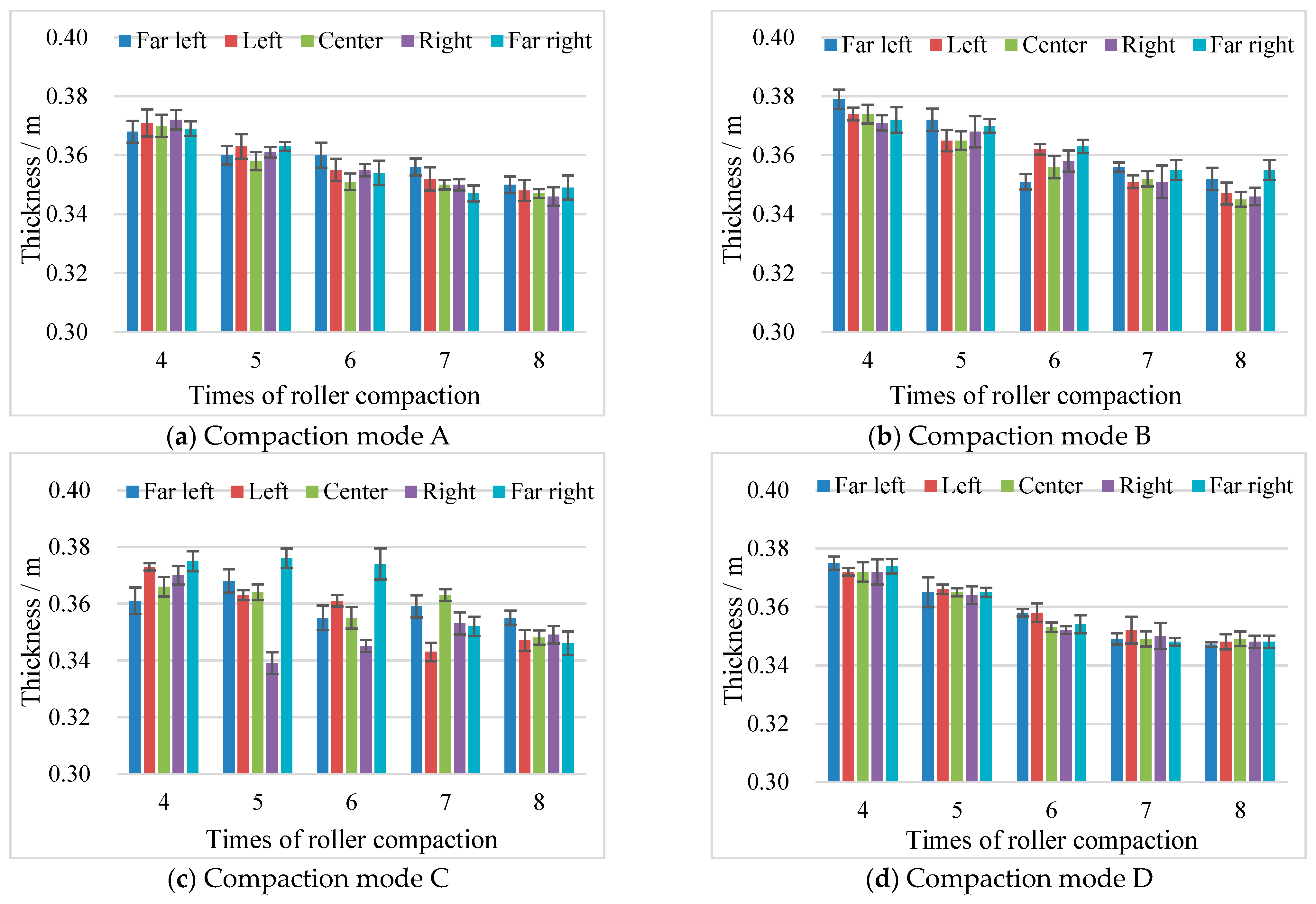
| Material | Apparent Density (kg·m−3) | Water Absorption Rate (%) | Crushing Value (%) | Moisture Content (%) |
|---|---|---|---|---|
| Brick aggregate | 2038 | 12.70 | 42.3 | 4.03 |
| Concrete aggregate | 2580 | 5.30 | 18.6 | 2.50 |
| Natural aggregate | 2863 | 1.01 | 13.2 | 1.23 |
| Material | Liquid Limit (Wl) (%) | Plastic Limit (Wp) (%) | Plasticity Index (Ip) (%) |
|---|---|---|---|
| Brick slag powder | 36.5 | 19.9 | 16.6 |
| Content of Brick Aggregate (%) | CBR (%) | Requirement of CBR (%) | Expansion Ratio (%) | Water Absorption Rate (%) |
|---|---|---|---|---|
| 0 | 36.1 | 8 | 0.017 | 7.6 |
| 20 | 34.2 | 0.017 | 10.0 | |
| 40 | 32.8 | 0.021 | 11.8 | |
| 60 | 28.4 | 0.031 | 10.6 | |
| 80 | 24.7 | 0.038 | 12.8 | |
| 100 | 18.4 | 0.044 | 13.1 |
| Mode | A | B | C | D |
|---|---|---|---|---|
| Compaction method | 2 strong vibrations + 3 weak vibrations | 3 weak vibrations + 2 strong vibrations | 1 strong vibration + 3 weak vibrations + 1 strong vibration | 2 weak vibrations + 2 strong vibrations + 1 weak vibration |
Disclaimer/Publisher’s Note: The statements, opinions and data contained in all publications are solely those of the individual author(s) and contributor(s) and not of MDPI and/or the editor(s). MDPI and/or the editor(s) disclaim responsibility for any injury to people or property resulting from any ideas, methods, instructions or products referred to in the content. |
© 2024 by the authors. Licensee MDPI, Basel, Switzerland. This article is an open access article distributed under the terms and conditions of the Creative Commons Attribution (CC BY) license (https://creativecommons.org/licenses/by/4.0/).
Share and Cite
Zhu, X.; Ding, L.; Wu, Y.; Wang, X.; Tan, X. Effect of Brick Aggregate Content on Performance of Recycled Construction-Solid-Waste Aggregate. Materials 2024, 17, 2616. https://doi.org/10.3390/ma17112616
Zhu X, Ding L, Wu Y, Wang X, Tan X. Effect of Brick Aggregate Content on Performance of Recycled Construction-Solid-Waste Aggregate. Materials. 2024; 17(11):2616. https://doi.org/10.3390/ma17112616
Chicago/Turabian StyleZhu, Xuan, Le Ding, Yuexing Wu, Xinzhong Wang, and Xianliang Tan. 2024. "Effect of Brick Aggregate Content on Performance of Recycled Construction-Solid-Waste Aggregate" Materials 17, no. 11: 2616. https://doi.org/10.3390/ma17112616
APA StyleZhu, X., Ding, L., Wu, Y., Wang, X., & Tan, X. (2024). Effect of Brick Aggregate Content on Performance of Recycled Construction-Solid-Waste Aggregate. Materials, 17(11), 2616. https://doi.org/10.3390/ma17112616






